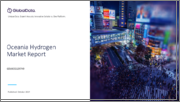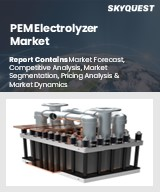
|
시장보고서
상품코드
1599132
오세아니아의 수소 시장 : 2024년Oceania Hydrogen Market Report - 2024 |
||||||
오세아니아, 특히 호주는 신재생에너지의 생산과 이용과 함께 국내 저탄소수소 시장을 개척하여 산업 및 대형 수송 등 탈탄소화가 어려운 분야를 탈탄소화하는 우선순위를 강조하고 있습니다.
오세아니아, 특히 호주는 가장 안정적인 수요와 가장 가치 있는 녹색 수출을 제공할 수 있는 섹터의 탈탄소화를 위해 수소를 이용하는데 특히 중점을 두고 있습니다.
저탄소 암모니아, 메탄올, 중수송은 세계적으로 충분한 수요가 있는 성숙산업으로 수소섹터의 규모 확대를 지지하고 국내 탈탄소화에 공헌하며 대규모 수출을 통해 경제에 공헌하기 위해, 중점이 있습니다.
다른 많은 지역과 마찬가지로, 운송은 여전히 저탄소 수소의 주요 최종 용도 부문이며 현재의 프로젝트 발표에 따르면 340만 톤/년에 가까운 생산 능력이 운송에 할당될 것으로 예상됩니다.
오세아니아, 특히 호주는 가장 안정적인 수요와 가장 가치 있는 녹색 수출을 제공할 수 있는 섹터의 탈탄소화를 위해 수소를 이용하는데 특히 중점을 두고 있습니다.
저탄소 암모니아, 메탄올, 중수송은 성숙 산업이며 세계적으로 충분한 수요가 있기 때문에 수소 섹터 확대를 지원하고 국내 탈탄소화에 공헌하며 대규모 수출을 통해 경제에 공헌 수 있습니다.
오세아니아, 특히 호주는 저탄소 수소 시장 개척을 가속화하고 지역 시장 수요를 확대하기위한 종합적인 정책 틀을 수립했습니다. 전략을 통해 자국을 아시아태평양 내의 얼리 무버로, 또한 저탄소 수소의 세계 허브로 자리매김하고 싶습니다.
이 보고서는 오세아니아의 수소 시장을 조사했으며, 시장 개요와 함께 오세아니아의 파이프라인 동향, 수소 프로젝트, 수소 생산 능력 및 주요 진출기업, 경쟁 구도 및 향후 전망 등을 요약합니다.
목차
- 개요
- 주요 요약
- 저탄소 수소 시장 현황
- 저탄소 수소 시장
- 세계의 상황에서 오세아니아
- 오세아니아의 파이프라인 수소 용량
- 지역 저탄소 수소 시장
- 세계 최대의 향후 수소 프로젝트
- 오세아니아 최대의 향후 수소 프로젝트
- 오세아니아의 수소 생산 능력과 주요 진출기업
- 수소 용량이 낮은 케이스와 높은 케이스의 시나리오
- 저탄소수소의 경쟁력의 원동력
- 저탄소 수소 도입의 큰 억제요인
- 주요 응용 분야 수요
- 오세아니아의 수소 이용 분야
- 수송
- 오세아니아의 암모니아
- 오세아니아 최대의 저탄소 암모니아 프로젝트
- 합성연료
- 오세아니아의 천연가스 수요
- 수소 파이프라인
- 화학 분야용 저탄소 수소
- 철강
- 정책, 프로젝트, 주요 진출기업
- 국가별 수소 생산 목표
- 수소 정책
- 지방 수소 정책 I, II, III
- 무역협정
- 오세아니아의 수소거래
- 수소를 추구하는 오세아니아 기업
Oceania, particularly Australia, has stressed the priority of developing a domestic low-carbon hydrogen market in conjunction with the production and use of renewable energies to decarbonise hard-to-abate sectors such as industrials and heavy transport.
Oceania, particularly Australia, has placed particular emphasis on using hydrogen for the decarbonisation of the sectors that can offer the most stable demand and most valuable green exports.
There is a focus on low-carbon ammonia, methanol and heavy transport as they are mature industries that have sufficient demand globally, which will support scaling the hydrogen sector, contribute to domestic decarbonisation and contribute to the economy through large-scale export.
Like with many other regions, transport remains the dominant end-use sector for low-carbon hydrogen, with nearly 3.4mtpa of production capacity being expected to be allocated to transport based on current project announcements.
Oceania, particularly Australia, has placed particular emphasis on using hydrogen for the decarbonisation of the sectors that can offer the most stable demand and most valuable green exports.
There is a focus on low-carbon ammonia, methanol and heavy transport as they are mature industries that have sufficient demand globally, which will support scaling the hydrogen sector, contribute to domestic decarbonisation and contribute to the economy through large-scale export.
Oceania, but primarily Australia, has established a comprehensive policy framework for accelerating low-carbon hydrogen development and growing its regional market demand. Through Australia's National Hydrogen Strategy, which includes incentives, initiatives and funding programs, it wants to position itself as an early-mover within APAC and a global hub for low-carbon hydrogen.
This is strengthened by numerous state-level initiatives that leverage each state's unique advantages to attract investment in developing low-carbon hydrogen within those regions. For example, the New South Wales Government launched the AUD3 billion NSW Hydrogen Strategy to provide a clear policy pathway to achieve competitive green hydrogen production.
Active hydrogen capacity in Oceania stands at 0.9ktpa in comparison to the 1.9mtpa of global total capacity. Oceania has the third largest upcoming hydrogen project in the world - the Western Green Energy Hydrogen Plant. 58% of Oceania's hydrogen projects are in the feasibility stage. Australia accounts for 98% of Oceania's hydrogen capacity. Oceania is the fourth largest region for pipeline hydrogen capacity. Transportation is listed as and end-use sector for over 3mtpa of low-carbon hydrogen capacity. Western Australia accounts for 55% of upcoming hydrogen projects supplying the synthetic fuels sector. Australia has a 2050 hydrogen production target of 15mtpa with a stretch potential of 30mtpa.
Scope
- Oceania low-carbon hydrogen capacity outlook, Key regional projects, Key companies operating in Oceania's hydrogen market, Hydrogen end-use sectors, Hydrogen policy in Oceania at both the national and state level, Deal activity related to hydrogen in Oceania, Company filings analysis of Oceania headquartered companies
Reasons to Buy
- Identify the market trends within the region and key players in hydrogen technologies.
- Develop market insight of current, in development and announced capacity and latest trends of the sector.
- Understand the region's different scenarios for 2030 based on the likeliness of the projects.
- Look at the demand in key application areas for the country.
- Facilitate the understanding on how and where the market is growing as it is rapidly scaling up to position as one of the main topics of the international and national agenda.
Table of Contents
Table of Contents
- Overview
- Executive summary
- Snapshot of the low-carbon hydrogen market
- Low Carbon Hydrogen Market
- Oceania in a global context
- Oceania's pipeline hydrogen capacity
- Regional low-carbon hydrogen market
- World's largest upcoming hydrogen projects
- Oceania's largest upcoming hydrogen projects
- Oceania hydrogen capacity and key players
- Hydrogen capacity low-case and high-case scenario
- Low-carbon hydrogen competitiveness drivers
- Major barriers to low-carbon hydrogen deployment
- Demand in Key Application Areas
- Intended use sectors for Oceania hydrogen
- Transportation
- Ammonia in Oceania
- Oceania's largest low-carbon ammonia projects
- Synthetic fuels
- Oceania's natural gas demand
- Hydrogen pipelines
- Low-carbon hydrogen for the chemicals sector
- Iron & Steel
- Policies, Projects, and Key Players
- Hydrogen production targets by country
- Hydrogen policies
- Sub-national hydrogen policies I,II,III
- Trade agreements
- Oceania hydrogen deals
- Oceanian companies pursuing hydrogen



















